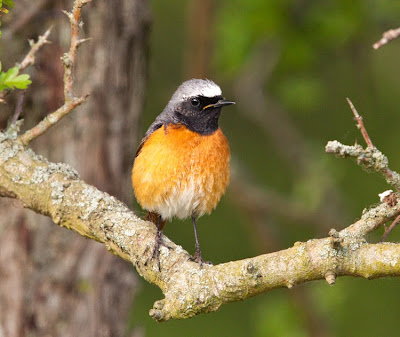Before this week I'd had good numbers of Blackcap, Chiffchaff, Common Whitethroat, Cetti's and a single Marsh Tit. This week though it's started to come into its own. On Tuesday evening I had a reeling Grasshopper Warbler and I've continued to hear it from different locations around Marston up to and including tonight. On Wednesday evening I had a singing Garden Warbler which had been joined by second male singing in the same area since yesterday. Sedge Warbler numbers have steadily increased since last weekend and this evening I had a Reed Warbler before I left at 8pm. All I need now is a Cuckoo! Which now that the Acros are in, are probably not too far away.
I tried all day today and yesterday to photograph the Garden Warblers but failed miserably. I'll leave them now and maybe they'll settle a little if some females come in. I did manage a decent shot of a male Reed Bunting singing from the top of a Hawthorn. It was pretty straightforward, every time I passed this bush along the path he was there, unperturbed by walkers or my lens pointing at him.
 |
| Singing male Reed Bunting, Marton Marshes, Norwich - 26th April 2014 |
Yesterday I did also head back over to the area between West Earlham and Bowthorpe Marshes where there would now appear to be at least two singing Nightingales (I suspect a third bird may even be there but I can't be certain). Hearing them was no problem but the only looks I got were as one bird dashed across the path from one Hawthorn to another or a dark shape moving around from deep cover. I stood by a Hawthorn at one stage with the bird singing loudly from within and I still couldn't see it. Here's a sound bite taken using my iphone. Excuse the poor quality but you get the idea.
Youtube link to sound of Nightingale singing
A Common Tern was also in the area but sadly no Arctics passing through (or Whiskered for that matter!).
At UEA I checked the slopes below the gorse near the NNUH and I was in luck. The male Ring Ouzel was still present although approach was difficult so all I could manage was this cropped record shot. This morning there was no sign of it but not to mean its gone, could just have been sitting in the hedgerow.
 |
| Ring Ouzel, UEA campus, Norwich - 26th April 2014 |






















